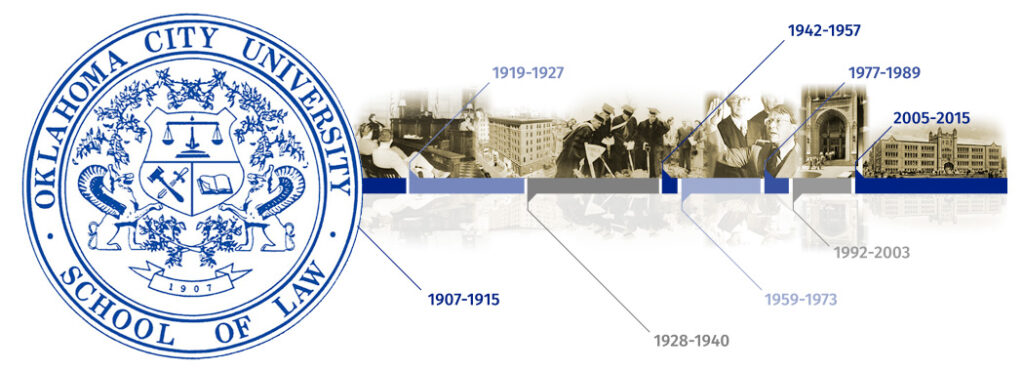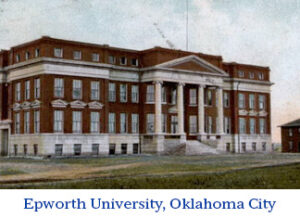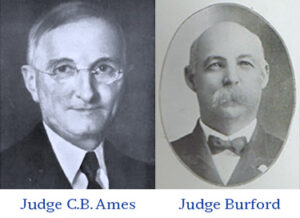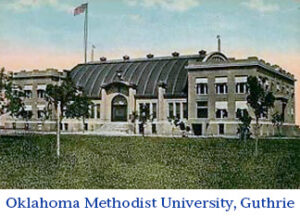History
Our History
Founded in 1907, Oklahoma City University School of Law was the first law school in the state of Oklahoma. At the time of its founding, our dynamic law school was known as Epworth University School of Law, and it was then that our proud tradition of educating skilled attorneys who graduate prepared to practice began.
As the first law school in the state, Oklahoma City University School of Law was established amidst the excitement and optimism, perseverance, and entrepreneurialism of statehood. In the fall of 1907, the first classes were held at Epworth University, a Methodist institution of higher education in Oklahoma City.
The dean of Epworth School of Law, Judge C.B. Ames, had two goals in those very early years: keep students from leaving the state to attend law school and produce great lawyers. He was going to achieve the latter by upping the coursework requirement from the standard two years to three. In August 1907, The Daily Oklahoman reported that “the object for which the law department at Epworth University is founded is to afford law students facilities for obtaining a legal education which will thoroughly equip them for the practice of law in any of the states of the union and more particularly in Oklahoma. The course will be comprehensive and of a standard equal to that of the foremost law schools in the United States.”
Faculty were selected from the Oklahoma Bar and special lecturers were identified, including practicing legal scholars such as Judge John H. Burford, the last chief justice of the Oklahoma territorial supreme court. The newspaper noted that 15 students were enrolled when Epworth began its first law classes in 1907, which made it the largest inaugural class for any law school in the country.
By its third year, Epworth Law was growing – more faculty, more students, and an increasing number of volumes in the library.
New Chapter
In 1909, the state university in Norman opened a law school. In a show of solidarity, Epworth University agreed to close its law school and consolidate with the new law school at the University of Oklahoma. Epworth donated its library to the new law school and OU granted diplomas to the seven 1910 Epworth Law graduates.
One year later, Epworth closed its doors and reopened in Guthrie, Oklahoma with a new name – Oklahoma Methodist University. Epworth’s chancellor, a number of its faculty, and many of its furnishings made the move to Guthrie, as well. The first classes were held at the new university in September 1911.
In 1919, trustees decided to close the Guthrie location and make a fresh start back in Oklahoma City with a new institution called Oklahoma City College. The college was built where Oklahoma City University stands today. The final transition came in 1924 when Oklahoma City College became Oklahoma City University.
Legal Education Renaissance
For many years, there was an underlying current of support for a law school in the capital city. As a result, during the ‘20s, ‘30s, and ‘40s, a number of proprietary law schools cropped up offering a legal education at night. One was Oklahoma City College of Law.
Beginning in the 1940s, Oklahoma City University President Dr. C.Q. Smith began discussing the purchase of Oklahoma City College of Law with its president Roger Stephens. The deal took more than a decade to finalize because Dr. Smith was waiting until the university received accreditation from the North Central Association. When the deal was finally complete, classes began September 12, 1952, with seven instructors, including longtime professor Wayne Quinlan for whom the Quinlan Lecture is named.
Oklahoma Supreme Court Justice Marian P. Opala was among the law school’s first graduates in 1953. At that time, the law school was located in the YMCA building downtown. Classes were held in the evening allowing students to work full-time and go to law school. In 1956, Oklahoma City University sold the YMCA building to Kerr McGee and the law school moved back to campus.
The Future
It was in 1907 that C.B. Ames had the desire to start a law school in Oklahoma City. He strove to establish a school accredited by the American Bar Association (ABA), one that was a member of the Association of American Law Schools (AALS), one that provided a rigorous course of education and prepared lawyers for the practice of law. Over the course of a century, that desire has become a reality. ABA accreditation came in 1960 and membership in AALS in 2003. With individualized instruction, prestigious guest lecturers, and the multitude of opportunities to get practical experience under the guidance of professionals, Oklahoma City University School of Law continues to exceed that vision.
In 2014, OCU Law seized the opportunity to move off the University’s main campus into the historically renovated Oklahoma (Central) High School building in downtown Oklahoma City. The first semester in the newly revitalized building commenced in January 2015, bringing the law minds of tomorrow into the center of the law community of today.
Positioned in the hub of the business, government, and law action of Oklahoma City, this brings exceptional opportunity for law students. Students can now conveniently participate in externships and volunteer programs, or enjoy a variety of fitness facilities, entertainment venues, restaurants, shopping, and sports activities – many within walking distance. The strategic location also offers incredible networking opportunities for students, while still earning their degree.
Today, OCU Law’s student body represents a rich tapestry of backgrounds, skills, abilities and perspectives. Here, everyone has an equal voice. And everyone enjoys the open-door atmosphere that connects our students and faculty.
The building OCU Law now occupies was designed by world-famous architect Solomon Andrew Layton in 1910. The building is a historical gem. Occupying an entire city block, it gives you access to the entertainment and culture of Downtown, Midtown, The Plaza, and Uptown 23rd. No law school in Oklahoma can match our vibrant location.




